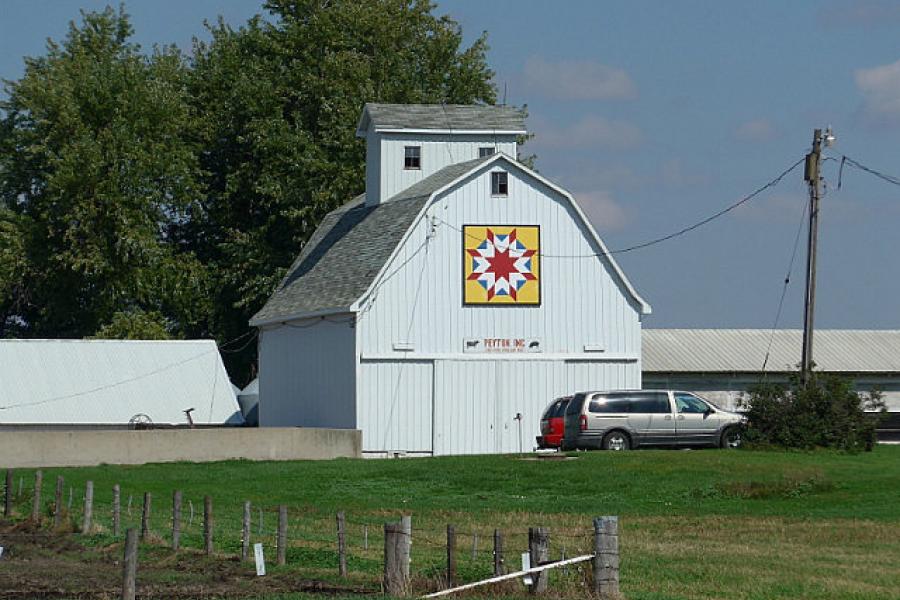The Heartland and why it matters (Originally posted 8 Oct 2014)
Country
Within a day of leaving the Black Hills we had crossed the Missouri River. We swept onto a long causeway almost unexpectedly. It was late in the afternoon, we were in a hurry and there was nowhere to stop and take in the scene. Jo had only a moment to snap a photo from the back of the bike. Despite all this, the event didn't pass without notice. Two days later and 1000 km due east in the state of Iowa, we crossed the Mississippi. We were more than 3000 km from the mouth of this mighty river system in the Gulf of Mexico but both rivers were wide and navigable and seething with commercial life. The Mississippi-Missouri River System is a foundation of American strength and central to the character of its people and it was worth a few days grinding through a never ending scape of corn and soy to understand what this means. But where to start? Perhaps some geography.
North America (Canada, the USA and Mexico) can be roughly divided into a number of broad bands running north-south. The coastal plain west of the Rocky Mountains, the arid high prairie in the eastern rain shadow of the Rockies, the broad fertile plain stretching east to the Appalachian Mountains and, finally, the coastal plain of the east coast. Of these, it is the central fertile plain that is the most important. This area, 3,225 square kilometres, is unique in the world. It is the largest contiguous fertile plain in the world stretching from the central plains of Canada to the Gulf of Mexico. There are, of course, other large fertile plains such as that in southern Russia and Kazakhstan but none of the others is serviced by the extensive network of navigable rivers that exists in the American heartland.
It is easy to see what this means in terms of productivity as you ride day after day through flourishing crops, but it is the river system, the mighty Mississippi and its tributaries, that allows that wealth to be realised and it secured the American future. No part of the fertile basin is more than 200 km from a navigable river and cost-effective transport to market. This is a humble task for the rail and road network. The water transport system is both cost-effective and secure. No enemy or competitor can interfere with it, buried deep in the continent and emptying into the easily secured Gulf of Mexico. The competitive advantage is substantial and the wealth it has created, and continues to create, very real. If this was a geopolitical lottery, the Greater Mississippi Basin would be the jackpot. The area of land under corn production alone would cover the whole of the country of Germany. By way of comparison, Britain today produces about 30% of its food requirements and relies for its security on external alliances. And, while Canada might share in the fertile basin, it relies on a tenuous system of canals joining the Great Lakes to get that wealth to market.
We rode for three long hard days through a never ending horizon of corn and soy, small prosperous farming towns, diner dinners and awful coffee. We could have ridden in any direction out beyond our wildest dreams of national wealth and seen nothing but the fecundity of this amazing land. It is this that first gave the USA the security to become an empire and it is this that allows it to remain one, confident that no challenger can emerge. It is this that has shaped the American mindset for here, in this limitless plain, a new settler could work hard and prosper and optimism was rewarded. The land and the rivers gave so much.
Much of the population of this land live in small towns and small cities and are the rightful inheritors of this character. They are optimistic, patriotic, religious and respectful. They reflect a rural population with rural sensibilities. Other places are not so fortunate and our own country is the archetype of the hard row. In Australia, failure was more common than success and the desert often reclaimed its own and more. The national character reflects this; a little cynical and little sardonic and not always optimistic. Australians, in comparison with the Americans, are urbanites with urban sensibilities. No wonder we often see members of these two English-speaking tribes talking but not communicating.
Millions of tourists visit the USA every year. Most go to see the major cities and the national parks all of which are impressive and admirable. Few ever wander unsupervised into the wilderness of crops that mark out the heartland. This is a shame, for any chance at a real understanding of this complex and difficult country must come to terms with this vast tract of land and its millions of highly productive inhabitants.
Finally, we did reach our far horizon and the plains petered out. We loped into the hills of Eastern Ohio with its small, compressed towns and poor small holdings. Our destination was the town of East Liverpool and we found it in the middle of a Sunday afternoon. We found its broken streets and empty shops, its faded past and lost future. It seemed like a town of lost dreams and there seemed to be nothing of value there for travellers like us. And yet, we had come to that place in search of a lost treasure. A story worth the search. All we had to do was find it.














